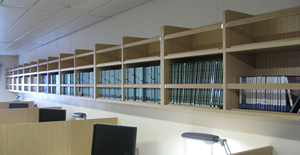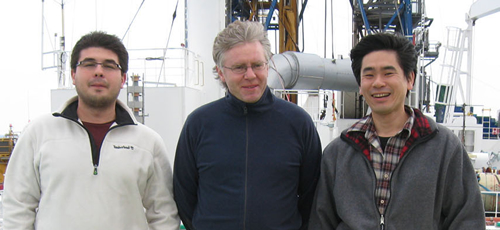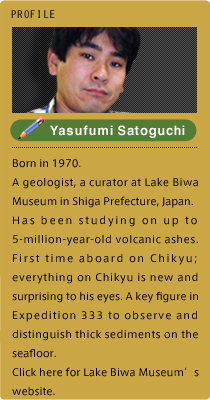

“It was my dream to be on Chikyu…”2010.12.20
Hi there, Konnichiwa. I am a scientist on board in Expedition 333, Dr. Satoguchi from Lake Biwa Museum. I am having busy days here. We are working in two shifts: the night shift starting from midnight and ending at midday, the afternoon shift from midday until midnight. I am working the night shift, so I feel like I am in a foreign country having jet lag, especially with English and French being spoken around me.
So, what did I say last time? Yes, I am going to introduce the scientists on board Chikyu. I think I should introduce myself first. As you know, Chikyu is operating drilling expeditions for Integrated Ocean Drilling Project (IODP), in which Japan is taking the leading part. IODP is an international project with a long history, which I knew about since I was a student. But, to me it was something that was happening in a remote world, so it was a kind of dream to do a research with such a great programme. In that context, I may say that I am making my dream come true right now.

Chikyu’s onboard archive filled with a fading line of historical research reports!
Since I was a student, I have been doing researches on the volcanic ash found within the strata formed in between several million to hundreds of thousands of years ago from today. The volcanic ash is usually whitish in colour within the strata, and it is quite shiny compared to mud and sand, which is why I enjoy looking at them. The reason why it is shiny is because the volcanic ash is mostly made of the substance called ‘volcanic glass’. Volcanic glass is a glass naturally made by volcanic eruption. Imagine the gleaming powdery glass spreading by volcanic eruption and lying in between those sober strata…!
When I am doing a research, I look at volcanic ash using a microscope. I think you will be convinced when you look into the microscope and see how beautiful they are. Are you getting more interested in volcanic ash now? And I am sure when you get interested in something, you may want to check it out more by yourself.
Now, I explained that the volcanic ash is erupted when volcano erupts; you can see it is actually happening today in some places in Japan, for example in Kagoshima Prefecture. However, what I am studying are not of those volcanic eruptions that are happening frequently in smaller scale, but of much larger ones which can cover the area with several hundreds kilometres radius in one eruption, or even one that can cover the entire Japanese Archipelago with its ash. In this expedition, I am looking into such volcanic ash spread in extensive areas.
For example, some volcanic ash erupted in Oita Prefecture approximately 900,000 years to 1 million years ago can be found in offshore Kii Peninsula where we are drilling in the current expedition and even in Osaka Plain. I am expecting to find various volcanic ash this time because they are also found in Osaka and around Lake Biwa. Now, you may want to ask the reason why I want to find such volcanic ash. Let me explain.
It is very important to know for the scientists like myself, whose focus of study is geological strata; from what kind of substances the layers are made of, how they are being layered and how long ago they were formed, etc. Such information is the basic data for the deeper researches which are to be followed up by many other scientists. If we can find the volcanic ash of which we already know the date of eruption, then that would lead us to establish the date of in which the strata were formed. Occasionally, some marks of earthquakes may be found in geological layers in seismogenic zones. The volcanic ash is one of the key factors to help us learn when the earthquake occurred. Also, volcanic ash can deposit in the sea as well as on the land. This way, we can compare and analyse what happened at seafloor and on land at corresponding times of the history.
On the other hand, it is also my responsibility to describe the recovered sediments. We are a team of 6 scientists called “sedimentologist”, 3 members each for the afternoon and night shifts. Within the sedimentologist, we have different roles to play. Mine is to take a little of the sediments and see what they are made of by using a microscope. At the beginning, I was wondering how much work was waiting for me out there? Well, I didn’t think it was just sampling some volcanic ash... Now I tell you what I do. Of course, we cannot be like “Here’s the recovered core! It’s simply sand. Finished!” and go idling. We do work hard in day and night shifts, 12 hours each without even a weekend. I used to say, “I like sediments macroscopy and I have been doing the volcanic ash microscopy for quite a while. So there should not be a problem...” But the next thing I said after being told what other factors were for me to look into was this. “...What!? Do I also have to describe microorganisms and fossils contained AND find out their rations!?” Yet, I was still capable to say “Actually, if I take a bit more time, I can categorise them into similar groups. No problem!” Then I found out the numbers of cores to describe. Oh no, there were so MANY of them, serious! Will I ever finish!? This is a huge amount of work...! Well, the number of slides to describe was reconsidered after the first meeting. So, I am doing it okay at the moment. But still, it is a hard work to keep looking into the microscope everyday on a ship, although Chikyu does not roll that much. As a team, we take each share of taking the sample cores in turn (this is also a hard work!) and I go bother or joke a bit with Jan from Norway (sedimentologist) and Koray from USA who is doing an analysis called XRD. Each day passes busily like this...
One day, I was talking to Dr. Moe Kyaw (Expedition Project Manager) about how busy we have been everyday, he told me it is better we scientists have plenty of things to do, because when we have idling time doing nothing, that’s when there’s something wrong with the drilling work. I was totally convinced by his saying.

Sedimentologists for night shift. From left: Koray, Jan and myself.
Yasufumi Satoguchi


















